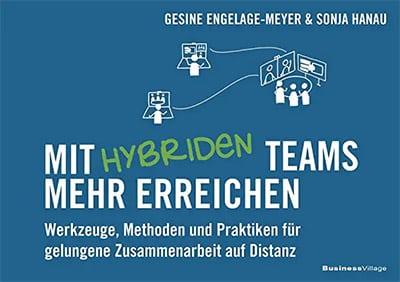Four tips for better meetings
Are you also one of those people who would like to have fewer or at least shorter meetings, but more time for important things? Welcome to the club. I too think fewer, shorter, better gatherings are desirable.
Unfortunately, most of us have got into the habit of just swiftly setting an appointment when faced with challenges. The scheduling is indeed very quick, but what eats up an infinite amount of time are the appointments themselves, especially if it is unclear to those involved what they actually want to achieve together. As the lack of clarity increases, so does the length and thus the unproductiveness of the meetings.
In this article, I suggest four tips that will help you have fewer, shorter, but better meetings.
Alternative approaches and what should be better after a meeting?
An effective first step in reducing meetings is to ask: Does it really have to be a meeting or can’t the issue be resolved at least as well in another way?
The answer, which is often surprising for many, is that another way is often at least as good!
Surprisingly, most employees know the following classic: invitations are only sent if the goal of the exchange is clear and transparent. How does that work in your company? I at least know numerous organisations that are familiar with the classic, yet the implementation is often neglected.
Of course, defining the objective is not always easy, but initiating an exchange with the hope that the goal will emerge in the course of the meeting is the wrong way to go. I know from personal experience and observation that it is always worthwhile to invest five or ten minutes in formulating an objective. The people who clearly know what they want from a meet-up can steer towards that very goal during the exchange. And this leads to tip #1:
Before you set a meeting next time, answer the following question for yourself and for everyone else in the invitation: “What do you want to be different after this meeting?”
Meeting process and objective
We set up many appointments to discuss certain issues with others, to hear opinions or to develop ideas together. In reality, however, it is often the case that usually only two or three people talk, if at all. In the worst case, someone presents a topic for 55 minutes and asks five minutes before the end: “Are there any questions?”
Of course, there is then often no time for an open discussion.
Tip #2: Design the meeting so that your objective can be achieved. Allow time for presentations, discussions, brainstorming, voting, etc.
For example, if your goal is to share as much information as possible, then a presentation might be the best option. Or maybe you could record a video that everyone can watch if it suits him or her?
When it comes to getting opinions out there and giving people the opportunity to think about a topic, it is helpful to use appropriate methods. My absolute favourite is to introduce 30 seconds or a minute of silence after asking a question. It feels unusual at first, but after a short time the participants are very grateful for these silent seconds in which they can let the content sink in and form an opinion.
Listening and thinking at the same time works for very few people, according to my observations. Popcorn, for example, which is passed on to another participant after someone has spoken, can help here. Such and other small, effective methods can also be found in the German book by Gesine Engelage-Meyer and myself: “Achieving more with hybrid teams”.¹
Joint documentation of the findings
You have probably also had the experience that words spoken are fleeting.
- “What did we discuss again?”
- “Who is doing what now and by when?”
- “When do we review the implementation and how?”
For progress and commitment, it is essential to document content. And do it in a place and in a way where it can be found again quickly. Exactly happens in very few cases. Because
- it is forgotten,
- no one feels like summarising the content,
- the next event is just around the corner.
And if someone does document the contents and findings, then in case of doubt not everyone will find themselves in the summary. Hence my practical tip #3:
Document the summary together. It is best to ask at the end of the meeting: “What was your most important insight?”
In online meetings, for example, the insights can be collected in the chat. If everyone then clicks on “Send” at the same time, you not only have a protocol with the most important, but with all perspectives taken into account. The whole thing usually only takes a minute, but in addition to the documentation it has the positive effect that at the end of the meeting everyone reflects on it and recognises what was most important for him or her.
Personal attitude to the meeting
Again and again I notice that people enter meetings with a consumer attitude, sit down, lean back and wait until the film starts. Of course, the moderator has a special responsibility to ensure that the exchange is successful and leads to the goal. At the same time, each individual participant also contributes to how the meeting goes.
The inner attitude is a largely underestimated factor. Do I go to an appointment with the attitude “Not another meeting…”, “Won’t do any good anyway…”, or do I think to myself “How nice: Now 7 people are taking time to discuss important issues together”?
Tip #4: Question your attitude before a meeting. A positive attitude can make a significant difference and thus actively contribute to the achievement of goals.
Conclusion
There are many ways to make meetings better. Some exchanges don’t have to take place at all, other encounters can be scheduled for shorter periods of time and, in principle, orientation towards objectives makes a lot of sense. The tips mentioned are a good start on the way to better meetings. Ideally, you should find out for yourself what works well for you and what does not work for you. It is sufficient to start with one point. Step by step your meetings will get better. That’ s a promise!
Notes:
[1] Here you can find a free reading sample of Mit hybriden Teams mehr erreichen – Werkzeuge, Methoden und Praktiken für gelungene Zusammenarbeit auf Distanz.
If you like the article or want to discuss it, feel free to share it with your network.

Sonja Hanau
Sonja Hanau does everything she can to ensure that there are fewer, but better meetings. For more than ten years, the business informatics specialist has been helping people to develop their potential and achieve their goals. She accompanies companies in developing a culture of cooperation. In her lectures and workshops, she combines moderation and technical competence with lightness and humour.
